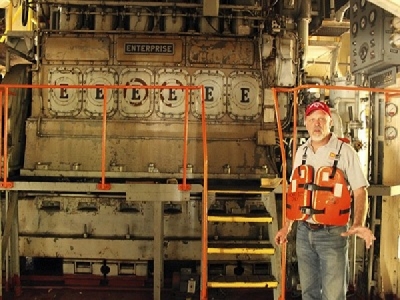
Posted on December 18, 2018
After decades of traveling the Mississippi, carving sediment out of the riverbed and reviving one of the most important commercial channels of the Midwest, the famed William A. Thompson Dredge of the U.S. Army Corps of Engineers (USACE) St. Paul District has been resting dormant off the coast of Prairie du Chien, Wis., for the past five years. Next June, unless its owners can find the $1 million needed for its transformation into a museum, the 267-foot-long vessel may be making its final voyage –– to the scrap yard.
The Dredge Thompson was in operation from 1937 to 2008, creating a nine-foot-deep navigation channel down the Mississippi River. At the time, it was the single largest piece of equipment in use by the USACE and the first dredge of its kind, able to dredge up to a 23.5-foot depth. It helped maintain 850 miles of the Upper Mississippi, and almost single handedly helped the region recover from the destructive Dust Bowl and Great Depression. In the process, the boat became a loved staple along the river near its home harbor in Fountain City.
The Dredge Thompson has been grounded since 2012, after the Prairie du Chien nonprofit Community Development Alternatives (CDA) purchased the boat from the federal government for $19.37 to turn it into a museum. That summer, it was towed from Fountain City to its current resting place, moored in a harbor on the north side of St. Feriole Island. Since then, CDA has been pursuing help in renovating the vessel into a museum centered on the Upper Mississippi, but it has come up empty handed.
“We have been attempting to find the money from either barge lines, foundations, federal agencies, humanities councils, and we have been unsuccessful in finding any funding for the maintenance and renovation of the vessel,” explained CDA Executive Director Dale Klemme.
In 2011, Homer Township resident Dave Belz and Winonan Bob Harris formed the nonprofit William A. Thompson Dredge Museum, and they too made a proposal to purchase the vessel. At the time, the organization was too new for the federal government to accept the proposal, but over the next five years, they planned to purchase the boat from CDA.
Klemme explained that CDA accrued more than $50,000 in costs from storing the vessel over the years, with no money coming in, so it had proposed that cost as the purchase price last summer.
“We needed that [$50,000] to cover the costs, and [Belz and Harris] would have been responsible for moving it. And we just never felt there was a commitment to do that,” Klemme said.
Harris and Belz eventually moved on to a new vessel: the Minnesota Centennial Showboat, a floating theater created by the University of Minnesota to celebrate the state’s centennial anniversary in 1958. The group purchased the boat earlier this year, and plans to bring the boat to rest in Winona sometime next summer.
Belz explained that they had still hoped to obtain the Dredge Thompson, but following years of attempts and a survey of the boat earlier this spring, they decided to move on.
“Bob went down to inspect the dredge in late spring and realized that it probably was not going to work out,” Belz said. “It had deteriorated to a point where it’s probably not even worth salvaging.”
In the meantime, the Dredge Thompson continued to sit idle.
According the Klemme, the vessel has lead paint and asbestos that must be dealt with before the public can enter or any renovations can made to turn it into a hallowed museum. And with museums, there’s also the worry of not making enough to cover the costs in the first place.
“Seasonal museums like this are not self-sufficient or self-sustaining. You need foundations and donations every year to feed it,” Klemme said.
Those costs have made the project prohibitively expensive –– Klemme explained that CDA would need $1 million to move the project to completion. With the past five years coming up empty handed, Klemme explained that for the dredge, the writing may be on the wall. “When you keep running into financial dead ends, you realize this is not going to happen,” he said. “It’s just hard to assume responsibility of it much longer if there isn’t any light at the end of the tunnel here.”
Despite the poor outlook, Klemme explained that there was one last effort to be made –– contacting the major barge lines directly. The organization has done it before, with little success, but with a deadline coming up soon, this is the dredge’s last option.
“They have deep pockets, and collectively they could do this in minutes. One-hundred-and-fifty-thousand dollars from each of them is chicken feed,” Klemme stated.
The Dredge Thompson, which for generations housed river workers as they traveled up and down the Midwest, is for many an icon of river life. When she was first moved from her home in Fountain City, dozens gathered along the shore at the corps headquarters, donned in T-shirts honoring the dredge, waving a farewell. They hoped that CDA could, in fact, preserve one of the most important river vessels to travel the Upper Mississippi in their lifetime.
If the final push fails, CDA will begin salvage operations in June and the Dredge Thompson will find its final resting place at the scrapyard. However, its fate is not set in stone, Klemme added, and he hopes that the group will be able to turn it around and find a home for the fabled vessel.
Source: winonapost





